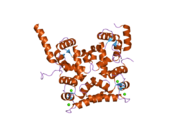Calcineurin B homologous protein 1

Calcineurin B homologous protein 1 is a protein encoded in humans by the CHP1 gene (formerly CHP).[5]
Function
[edit]The protein encoded by this gene is a phosphoprotein that binds to the sodium-hydrogen exchangers (NHEs). This protein serves as an essential cofactor which supports the physiological activity of NHE family members. It has protein sequence similarity to calcineurin B and it is also known to be an endogenous inhibitor of calcineurin activity.[5]
Interactions
[edit]Calcineurin B homologous protein 1 has been shown to interact with
- sodium-hydrogen antiporter 1,[6][7][8]
- sodium-hydrogen antiporter 3,[6] and
- sodium-hydrogen anti porter 9.[9]
References
[edit]- ^ a b c GRCh38: Ensembl release 89: ENSG00000187446 – Ensembl, May 2017
- ^ a b c GRCm38: Ensembl release 89: ENSMUSG00000014077 – Ensembl, May 2017
- ^ "Human PubMed Reference:". National Center for Biotechnology Information, U.S. National Library of Medicine.
- ^ "Mouse PubMed Reference:". National Center for Biotechnology Information, U.S. National Library of Medicine.
- ^ a b "Entrez Gene: CHP calcium binding protein P22".
- ^ a b Inoue H, Nakamura Y, Nagita M, Takai T, Masuda M, Nakamura N, Kanazawa H (Feb 2003). "Calcineurin homologous protein isoform 2 (CHP2), Na+/H+ exchangers-binding protein, is expressed in intestinal epithelium". Biological & Pharmaceutical Bulletin. 26 (2): 148–55. doi:10.1248/bpb.26.148. PMID 12576672.
- ^ Lin X, Barber DL (Oct 1996). "A calcineurin homologous protein inhibits GTPase-stimulated Na-H exchange". Proceedings of the National Academy of Sciences of the United States of America. 93 (22): 12631–6. Bibcode:1996PNAS...9312631L. doi:10.1073/pnas.93.22.12631. PMC 38044. PMID 8901634.
- ^ Pang T, Su X, Wakabayashi S, Shigekawa M (May 2001). "Calcineurin homologous protein as an essential cofactor for Na+/H+ exchangers". The Journal of Biological Chemistry. 276 (20): 17367–72. doi:10.1074/jbc.M100296200. PMID 11350981.
- ^ Zhang-James Y, DasBanerjee T, Sagvolden T, Middleton FA, Faraone SV (Dec 2011). "SLC9A9 mutations, gene expression, and protein-protein interactions in rat models of attention-deficit/hyperactivity disorder". American Journal of Medical Genetics Part B. 156B (7): 835–43. doi:10.1002/ajmg.b.31229. PMC 3168688. PMID 21858920.
Further reading
[edit]- Robertson NG, Khetarpal U, Gutiérrez-Espeleta GA, Bieber FR, Morton CC (Sep 1994). "Isolation of novel and known genes from a human fetal cochlear cDNA library using subtractive hybridization and differential screening". Genomics. 23 (1): 42–50. doi:10.1006/geno.1994.1457. PMID 7829101.
- Barroso MR, Bernd KK, DeWitt ND, Chang A, Mills K, Sztul ES (Apr 1996). "A novel Ca2+-binding protein, p22, is required for constitutive membrane traffic". The Journal of Biological Chemistry. 271 (17): 10183–7. doi:10.1074/jbc.271.17.10183. PMID 8626580.
- Lin X, Barber DL (Oct 1996). "A calcineurin homologous protein inhibits GTPase-stimulated Na-H exchange". Proceedings of the National Academy of Sciences of the United States of America. 93 (22): 12631–6. Bibcode:1996PNAS...9312631L. doi:10.1073/pnas.93.22.12631. PMC 38044. PMID 8901634.
- Lin X, Sikkink RA, Rusnak F, Barber DL (Dec 1999). "Inhibition of calcineurin phosphatase activity by a calcineurin B homologous protein". The Journal of Biological Chemistry. 274 (51): 36125–31. doi:10.1074/jbc.274.51.36125. PMID 10593895.
- Pang T, Su X, Wakabayashi S, Shigekawa M (May 2001). "Calcineurin homologous protein as an essential cofactor for Na+/H+ exchangers". The Journal of Biological Chemistry. 276 (20): 17367–72. doi:10.1074/jbc.M100296200. PMID 11350981.
- Matsumoto M, Miyake Y, Nagita M, Inoue H, Shitakubo D, Takemoto K, Ohtsuka C, Murakami H, Nakamura N, Kanazawa H (Aug 2001). "A serine/threonine kinase which causes apoptosis-like cell death interacts with a calcineurin B-like protein capable of binding Na(+)/H(+) exchanger". Journal of Biochemistry. 130 (2): 217–25. doi:10.1093/oxfordjournals.jbchem.a002975. PMID 11481038.
- Nakamura N, Miyake Y, Matsushita M, Tanaka S, Inoue H, Kanazawa H (Sep 2002). "KIF1Bbeta2, capable of interacting with CHP, is localized to synaptic vesicles". Journal of Biochemistry. 132 (3): 483–91. doi:10.1093/oxfordjournals.jbchem.a003246. PMID 12204119.
- Pang T, Wakabayashi S, Shigekawa M (Nov 2002). "Expression of calcineurin B homologous protein 2 protects serum deprivation-induced cell death by serum-independent activation of Na+/H+ exchanger". The Journal of Biological Chemistry. 277 (46): 43771–7. doi:10.1074/jbc.M208313200. PMID 12226101.
- Inoue H, Nakamura Y, Nagita M, Takai T, Masuda M, Nakamura N, Kanazawa H (Feb 2003). "Calcineurin homologous protein isoform 2 (CHP2), Na+/H+ exchangers-binding protein, is expressed in intestinal epithelium". Biological & Pharmaceutical Bulletin. 26 (2): 148–55. doi:10.1248/bpb.26.148. PMID 12576672.
- Pang T, Hisamitsu T, Mori H, Shigekawa M, Wakabayashi S (Mar 2004). "Role of calcineurin B homologous protein in pH regulation by the Na+/H+ exchanger 1: tightly bound Ca2+ ions as important structural elements". Biochemistry. 43 (12): 3628–36. doi:10.1021/bi0360004. PMID 15035633.
- Andrade J, Pearce ST, Zhao H, Barroso M (Dec 2004). "Interactions among p22, glyceraldehyde-3-phosphate dehydrogenase and microtubules". The Biochemical Journal. 384 (Pt 2): 327–36. doi:10.1042/BJ20040622. PMC 1134116. PMID 15312048.
- Ben Ammar Y, Takeda S, Sugawara M, Miyano M, Mori H, Wakabayashi S (Oct 2005). "Crystallization and preliminary crystallographic analysis of the human calcineurin homologous protein CHP2 bound to the cytoplasmic region of the Na+/H+ exchanger NHE1". Acta Crystallographica Section F. 61 (Pt 10): 956–8. doi:10.1107/S1744309105030836. PMC 1991313. PMID 16511206.
- Mishima M, Wakabayashi S, Kojima C (Jan 2007). "Solution structure of the cytoplasmic region of Na+/H+ exchanger 1 complexed with essential cofactor calcineurin B homologous protein 1". The Journal of Biological Chemistry. 282 (4): 2741–51. doi:10.1074/jbc.M604092200. PMID 17050540.
External links
[edit]- Human CHP1 genome location and CHP1 gene details page in the UCSC Genome Browser.








